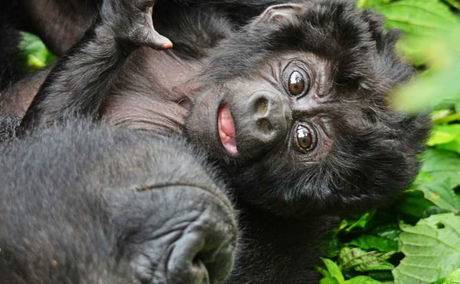The River Nile, the longest river in the world, offers a thrilling array of adventure activities, especially around Jinja, Uganda. One of the most popular activities is white water rafting, where adventurers can tackle some of the world’s finest Grade 5 rapids1. This exhilarating experience is perfect for both beginners and seasoned rafters, providing a mix of intense rapids and calmer stretches to enjoy the stunning scenery.
Things To Do In Virunga Region Apart From Gorilla Trekking
Enchanting Canoe ride on lake Mulehe-Kisoro south western Uganda
This photographic tour will unveil to you picture perfect volcanoes and life in a typical Ugandan village. It takes place in Kisoro, a District at the border of Uganda with Rwanda that is packed with rolling hills and Mountain Ranges. In between them are sensational crater lakes, a perfect example being Lake Mulehe.
THINGS TO DO IN VIRUNGA REGION APART FROM GORILLA TREKKING
Enchanting Canoe ride on lake Mulehe-Kisoro south western Uganda
This photographic tour will unveil to you picture perfect volcanoes and life in a typical Ugandan village. It takes place in Kisoro, a District at the border of Uganda with Rwanda that is packed with rolling hills and Mountain Ranges. In between them are sensational crater lakes, a perfect example being Lake Mulehe. The smoothness and quietness of this crater lake has a healing effect on the mind, body and soul. What’s more, the dug out canoe upon which you will have the tour is small and made for an intimate connections with nature. This makes this two hours’ trip special. As opposed to being powered by a motorized engine which would disturbs the peace of birds, it is steered by paddles. As such, the tour unfolds quietly, enabling see lots of shy birds, like the malachite kingfisher.
The guides are local born and raised with eloquent Ugandan English. They are very conversational in their approach to describing the history, architecture and how the different natural features in the area were formed. Even better, the atmosphere is relaxed because the lake is not busy.
Relaxing holidays at Lake Bunyonyi
Bunyonyi is a wondrous paradise waiting to pamper you exquisitely with natures aura/beauty. It is a beach-front destination with lots or cozy resorts where you can cool off after gorilla trekking. While at it, you will be treated to sensational sights and sweet sounds of small beautiful birds. That’s why its called Bunyonyi, a word in Rukiiga for a rejuvenating place with lots of small birds.
With an average depth of 39 m (128 ft), and a maximum depth of 130 ft (40 m), it is ranked as Africa’s second deepest lake after Tanzania’s lake Tanganyika. It is dotted with 29 small islands that are well laid out. During your visit, we shall organize for you a sight seeing boat cruise that offers a first class ticket to seeing their beauty. Brace yourself to see lots of native bird species hovering back and forth in search for small fish.
You don’t have to worry about having a bumpy ride. The lake which covers 61 Km2 is calm and free of hailstorms. It is surrounded by soaring ranges and highlands.
The guide is super easy to talk to and does an excellent job to ensure you have a fun and unforgettable tour. He is full of positive energy and knows where some of the most fascinating historical treasures are found. One such is Akampeni, a relatively submerged Island where girls who got pregnant before marriage were dumped to die.
Don’t forget to carry with you a camera, swim suit and towel. The water is free of Bilharzia and offers a rejuvenating swimming experience.
Kisiizi waterfall will leave you breathless
Kisiizi is one of Uganda’s most cherished destinations for ziplining, volunteering, cultural tourism and sight seeing. With an estimated height of 40 meters, it is one of Uganda’s highest waterfalls. It has been flowing non-stop for over 200 years now. You can walk up to it’s foot and feel its refreshing splash. Here, you will find colourful rainbows.
Historical significance: At Kisiizi, countless girls from the Bakiiga tribe who got pregnant before marriage were executed by being pushed off the cliff of falls. Why? They were considered unworthy of marriage because no potential suitor would be interested in “damaged goods”. This meant the girls family would miss out on dowry like cows, a source of wealth. To this effect, pre-marital pregnancy was an abomination and punishable by death. The good news is that the practice was banned over 100 years ago following the intervention of the missionaries.
The guide who will take you for this tour is good at spicing up the tour with humour and balancing it with respect for those who lost their lives here.
To see the full dimension of Kisiizi, you can hike from it’s foot to it’s summit. The hike to the top of the ridge is tough but short and breathtaking. The beauty is that there are not many tourists around. This gives you a sense of privacy. You could have a picnic at one of the spots with unobstructed views of the falls. If lucky, you will even see monkeys skilfully jumping from one tree to another like spiderman.
Great Lakes Museum
A day’s visit here is as good as a month long tour of the 12 major Kingdoms of Western Uganda and Rwanda namely Tutsi, Ankole, Bunyoro, Tooro, Bahiima, Bakiiga, Bufumbira, Hutu. It showcases their traditional ways of life in detail, with a prime focus on how they used to live in the prehistoric times. It further explains how men used to live in comparison with women.
The museum is found in Ntungamo District, along Kabale-Ntungamo highway. It boasts of well preserved exhibits/antiques ranging from traditional weapons used during civil wars, like spears, catapults, bow and arrows. You will also find different types of drums that were used to grace harvest festivals and occasions. The biggest highlight is centered on traditionally made domestic items like clay pots, knives made using iron-smith methods.
Throughout this tour, you will be in the hands of a guide who welcomes any questions and offers a great suggestions of areas to take pictures.
Bird watching in Bwindi Impenetrable Forest National Park
During this trip, you will delve deep into jungles where you will find and entire world of 350 recorded bird species waiting for you. The list includes some of the 20 most sought birds of Uganda, especially montane-forest residents such as African Green Broadbill, Shelley’s Crimsonwing, Short-tailed Warbler, Doherty’s Bushshrike and Bar-tailed Trogon.
On the part of the 23 Albertine endemics found here, Neumann’s warbler and Blue-headed sun-bird are the easiest to see. They love flaunting their beautiful feathers for all to see.
To double your chances of sighting your target species, pay close attention to every vegetation or feature in the forest. Most of the birds have mastered the art of camouflaging with the surrounding thanks to the matching colour of their feathers. Such include Yellow-streaked greenbul, Western green tinkerbird and Black-billed turaco.
During this experience, you will be astonished by the sense of peace and calm in this world beneath the canopy. As the sun ascends over the forest, its rays will penetrate through the canopy, creating a more lively ambiance. All over a sudden, butterflies will start flying within inches from you.
March and September present the most remarkable birding experiences because they are the peak of the breeding season. On the other hand, migratory species can best be seen from November to April.
Hiking Mountain Nyiragongo
This experience has been featured in National Geographic television shows multiple times. It entails exploring a part of Africa with the richest concentration of active volcanoes, Eastern Democratic Republic of Congo. One such is Nyiragongo, a volcano that last erupted in 2002 an sits at 3,470 m (11,380 ft) above sea level. Atop its summit is a lava lake with bubbling magma surrounded by towering walls of solid rock. The views and lava flow pattern here will offer you a wowing perspective on the path of the recent Volcanic eruptions of 2002. According to Scientific findings by National Geographic, it’s next eruption is expected to take place in 2030. Until then, the mountain is safe to hike. In the philosophy of MJ safaris, we shall ensure your tour is handled professionally and all safety aspects are attended to.
At the climax of your tour, you can relax in comfort in the well insulated huts at the crater rim. From here, you can casually watch the volcano light up the sky brightly with it’s yellow-orange glow. It is such a spectacular view. You will not believe your eyes. Sleeping bags are available for hire in case you need extra comfort.
Your tour will consist of a lovely packed lunch. The dinner options are usually beef, chicken, and a vegetable wrap. If you have alternative preferences, the chef is always happy to fix it for you. You will also be offered hot tea to keep you warm.
Keep in mind that you should stay hydrated. If possible, you can start drinking before the hike starts to ensure you are not dehydrated. You can bring your own bottles for water, you will be provided filtered mineral water.
In overall, this tour is magical. You won’t regret biting the bullet to make the memories happen.
To get the best pictures, bring a DSLR camera. Your iPhone/Pixel won’t get that shot full of wow factors.
Awe-inspiring Nature walk in Bwindi
This half day adventure offers a great way for you to indulge, recharge and renew your positive energy. The park is awe-inspiring, misty, lush and green. It is as serene as it gets. You will come across enthralling natural ponds where you can have a refreshing swim. The trails are en-route unique flora and fauna, several of which are not found anywhere else. This mostly comprises of species with lush canopy like Newtonia buchananii, Strombosia scheffleri and Prunus Africana, the list goes on. If its your lucky day, you might find gorillas wandering at their feet in search for food. Colors change from bright green to dark green as you get deeper into the forest.
Thanks to the underground rocks that filters the rainfall and runoff, the water here is so clear. You can easily view schools of tropical fish as they swim at the bottom of the pond. Your soul will cascade along the roaring waterfalls that feed them.
As the sun warm’s up the forest in the morning, butterflies light up the atmosphere as they flap their colourful wings while flying. This presents a perfect opportunity for you to compare and contrast features of 220 butterfly species found in the park. Three of these are found no-where else on earth; Graphium gudenusi, Charaxes fournierae and Papilio leucotaenia.
Further Reading
There has been an ongoing debate for years on which is the best time to trek gorillas or track gorillas in Uganda and Rwanda. Several arguments and opinions have been voiced in different avenues including online forums such as TripAdvisor and Lonely Planet among others. The fact is that gorillas in Uganda and Rwanda can be tracked throughout the year and clients almost get the same satisfaction. This is because clients tend...
Uganda Airlines has announced a new route to Gatwick London, starting in October 2024. The airline will operate three flights per week on this route, using Airbus A330-800neo aircraft. This new route will be a welcome addition for travelers between Uganda and the United Kingdom. It will provide more options for travelers, and it will also help to boost tourism in both countries.








Share This Post